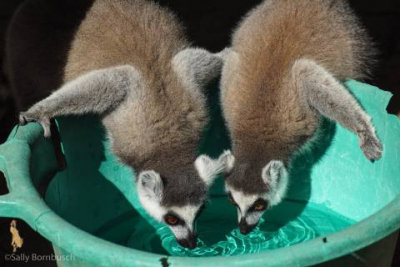Drug-Resistant Bacteria Found In The Guts Of Lemurs Who Live Around Humans

DURHAM, N.C. – Antibiotic resistance, which the CDC calls one of the world’s most urgent public health crises, is now being found in the guts of lemurs, our distant primate cousins.
In a new study appearing Aug. 9 in the journal Frontiers in Ecology and Evolution, Duke researchers have found evidence for antibiotic resistance in the microbiome of lemurs living close to humans. And the closer the contact, the more antibiotic resistance they found.
The research team, graduate student Sally Bornbusch and Christine Drea, Professor of Evolutionary Anthropology at Duke University, sampled the dung of ring-tailed lemurs and sequenced the genes of all microbes found there, looking for genetic markers of antibiotic resistance.
The study compared 10 lemur populations: seven wild populations in Madagascar, two from research facilities --the Lemur Rescue Center in Madagascar and the Duke Lemur Center in the United States --and finally a group of lemurs kept as pets in Madagascar.
In wild animals, the average proportion of resistance genes in the gut microbiomes was close to zero. But in animals from research facilities, that proportion was more than 25 times greater than in wild lemurs. In pet lemurs, the proportion was almost 35 times greater.
Some of this is likely due to good veterinary care: lemurs living in research facilities are treated for infections when needed, and so have greater direct exposure to antibiotics than their wild cousins.
However, pet lemurs that likely never receive veterinary care harbored the highest abundance of antibiotic resistance genes.
Keeping a lemur as a pet is illegal in Madagascar, so those who keep lemurs are unlikely to take these animals to a veterinarian and risk facing legal consequences. These pet lemurs are therefore acquiring the antibiotic resistant microbes simply by sharing their environment with humans and domestic animals.
Ring-tailed lemurs are omnivores and generalists who will eat dirt, excrement, and whatever they can get hold of. In a domestic household, they are often in constant contact with humans, perched on their owner’s shoulders, or in the arms of tourists willing to pay for a photo (a practice that is harmful to both humans and animals).
Bornbusch said that this physical and social environment is apparently contributing to pet lemurs’ antibiotic resistance.
“Microbes are like an overlaying blanket on everything. They're not only in our guts, but also on our skin, our furniture, and in our food and water,” Bornbusch said. “They're everywhere, all the time, and they are easily transmitted between environments.”
Among wild lemurs, antibiotic resistance varied along a gradient of human activity. Animals from areas impacted by cattle grazing, farming, or tourism harbored more antibiotic resistant microbes than those from more pristine environments, but still far less than lemurs living in close proximity to humans.
“Antibiotic treatment is clearly not the only mechanism leading to a higher abundance of resistance genes in these animals,” Bornbusch said.
In fact, even among lemurs housed at research facilities, those with no previous antibiotic treatment harbored similar numbers of antibiotic resistance genes compared to lemurs at the same facility that had been treated many times for infections.
Proximity to humans also determined the type of resistance genes that were acquired. The microbiomes of ring-tailed lemurs from Madagascar showed signs of resistance to antibiotics used to combat outbreaks of plague, while lemurs from the Unites States showed resistance to antibiotics frequently prescribed in North America.
Antibiotic resistance genes are nothing new. Microbes have been mutating and evolving resistance genes for millions of years in an arms race with naturally occurring antibiotics.
In a natural scenario, this process rarely poses problems. But things started to go awry when humans harnessed the power of naturally occurring antibiotics and released man-made antibiotics to the public.
“Humans came along, developed antibiotics, spread them all around us, and propagated these resistance genes into natural environments and into the microbiomes of wildlife,” Bornbusch said. Though grim, these results can have a positive impact on conservation and wildlife management practices.
“Even if these results are slightly scary, they help us use microbiome science to hone veterinary practices and conservation activities,” Bornbusch said. She also said that more research is needed to better understand the impact of these resistance genes on wildlife.
“Right now, we know that these resistance genes are out there, but we don’t know whether they are truly harmful to lemurs,” said Bornbusch. “These results give us a stepping-stone for research on the impact of these resistant microbes on wildlife and their environment.”
Funding for this study came from an NSF Doctoral Dissertation Research Improvement Grant to Bornbusch and Drea (award #1945776), an NSF Behavioral and Cognitive Sciences Grant to Drea (award# 1749465), a Graduate Student Research Grant to Bornbusch from the Triangle Center for Evolutionary Medicine, and a Research fellowship to Bornbusch from The Kenan Institute for Ethics at Duke University.
CITATION: “Antibiotic Resistance Genes in Lemur Gut and Soil Microbiota Along a Gradient of Anthropogenic Disturbance,” Sally Bornbusch and Christine Drea. Frontiers in Ecology and Evolution, Aug. 9, 2021. DOI: 10.3389/fevo.2021.704070
